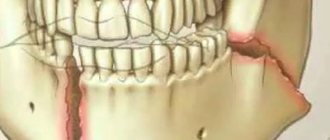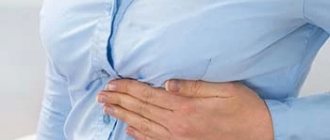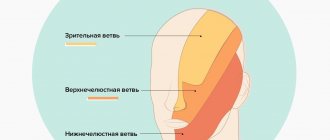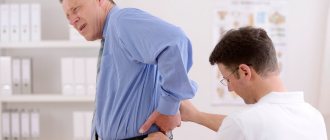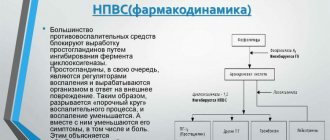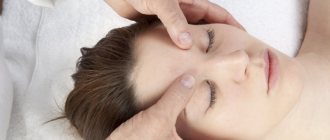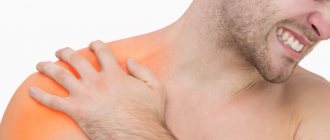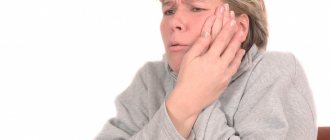Neurologist (algologist)
Vasilenko
Marina Gennadievna
25 years of experience
Head of the Pain Treatment Center, neurologist-algologist, member of the Society of Neurologists and Neurosurgeons, Russian Society for the Study of Pain, Association of Interdisciplinary Medicine, International Association for the Study of Pain (IASP)
Make an appointment
Occipital neuralgia is a disease of neurological origin, which is associated with irritation of the nerve roots in the occipital region. The pathology affects pairs of spinal nerves: the lesser and greater occipital nerves. The inflammatory process compresses and irritates these nerves, creating constant pain and reducing the quality of life of patients. Inflammation, according to the degree of origin, can be primary and secondary (against the background of lesions of the cervical vertebrae), and is also divided into neuralgia of the greater occipital nerve and neuralgia of the lesser occipital nerve.
Symptoms
Signs of inflammation of the occipital nerve are the following:
- throbbing pain in the head, ears, temples, lower jaw;
- dizziness and nausea;
- causeless lacrimation;
- discomfort from touching the affected area;
- a haunting feeling of cold;
- change in skin color.
Symptoms of occipital neuralgia:
- paroxysmal shooting pains;
- the duration of the attack is several hours;
- imitation of migraine symptoms;
- localization of pain in the occipital region;
- limitation of head mobility;
- increased sensitivity of the skin at the site of inflammation;
- change in skin color at the site of inflammation.
The pain can be constant, dull or burning.
A distinctive feature of inflammation of the occipital nerve is the presence of trigger points. The slightest pressure on them results in acute pain, so they must be protected from exposure until the disease is completely cured.
Are you experiencing symptoms of occipital neuralgia?
Only a doctor can accurately diagnose the disease. Don't delay your consultation - call
Causes of headaches behind the ears
A headache in the ear area is a symptom of various pathologies that can cause significant harm to health. Doctors advise paying attention to the first symptoms, as diseases can progress. Painful sensations behind the ears can be accompanied by fever, hearing loss and other complaints - they must be taken into account during diagnosis.
Diseases of the hearing organ
The main reason why a headache behind the ear on the left or right is due to diseases of the hearing organ. Discomfort can be caused by inflammatory processes or damage in any of its parts. The hearing organ is divided into the outer, middle and inner ear. The outer part is represented by the auricle, ear canal and eardrum. The main function of the middle ear is to equalize pressure in the outer and inner sections. The inner ear has the most complex structure and is called the labyrinth. It is he who recognizes sound vibrations and transmits them to the cerebral cortex.
Chronic or throbbing pain in the head behind the ear may be the first sign of the following diseases:
- Otitis is an inflammation of the outer, middle or inner ear. The disease is accompanied by acute pain and discomfort. An advanced process can be complicated by purulent inflammation, in which case discharge from the ear canal appears.
- Labyrinthitis is a dangerous disease, inflammation of the labyrinth of the inner ear. The process is often one-sided, manifesting itself on the left or right side. Complaints include not only headaches, but also nausea and loss of coordination. The labyrinth is responsible not only for the perception of sounds, but also for balance.
- Meniere's disease is a pathology of non-infectious origin. Its main symptom is an increase in the volume of endolymph, the fluid in the inner ear. It is manifested by chronic unilateral pain behind the ear, nausea, and decreased hearing acuity.
- Mastoiditis is an inflammatory process that affects the process of the temporal bone. It can be caused by injury, viral or bacterial infection. It is accompanied by elevated temperature, a sharp deterioration in health, and purulent discharge from the auditory canals. The disease is more often diagnosed in children than in adults.
- Fungal diseases (otomycosis) - cause inflammatory reactions, itching and irritation. The infection most often affects the external parts of the hearing organ. In the initial stages, the fungus is not dangerous, but without treatment it can become complicated by purulent processes.
Head pain in the ear area is a dangerous phenomenon, since it may indicate various diseases of the hearing organ. Pathological processes without timely treatment spread to the internal parts. Air deficiency and the presence of endolymph provide a favorable environment for the development of bacterial infection. Its development is dangerous due to purulent inflammation, which can cause damage to the membranes of the brain and deterioration of hearing until it is completely lost.
Infectious diseases
Seasonal colds, acute respiratory viral infections and influenza are common diseases that affect adults and children. They are caused by a viral infection and are transmitted through airborne droplets and household routes. They can be recognized by their characteristic features:
- headaches behind the ears, as well as in the forehead and back of the head;
- increase in body temperature to 37 degrees or more;
- nasal congestion, swelling of the mucous membranes;
- cough, sore throat, redness and soreness;
- general weakness, drowsiness, decreased performance.
With viral diseases, the temperature rises already in the first days after the infection becomes active. This sign, combined with pain in the head near the ear, indicates the need to stay in bed, drink plenty of fluids and take supportive medications. However, if your health suddenly deteriorates, self-medication will be harmful. Even a common cold can be complicated by pneumonia or spread to the membranes of the brain if the immune system is weakened and cannot cope with the infection.
Other reasons
If your head hurts behind your ears, this may indicate various disorders. This symptom accompanies various infectious and non-communicable diseases that occur in acute or chronic forms. As a result of the diagnosis, pathologies may be detected that require urgent treatment.
- Migraine is a chronic disease that manifests itself as a one-sided headache, but can affect the entire surface of the head. Its exacerbation can be caused by hormonal changes, changes in atmospheric pressure, stress and other reasons. Migraine is often diagnosed in middle-aged women.
- Lymphadenitis is inflammation of the lymph nodes. In the ear area there are auricular, occipital and cervical lymph nodes. They can become inflamed due to previous infectious diseases, as well as with pathologies of the immune system. Superficial nodes are felt under the skin in the form of round, painful, dense formations. In an acute process, redness of the skin over the affected area and an increase in general body temperature may be observed.
- Shingles is a fungal disease that is transmitted by contact. Its pathogen can also be found on towels, bedding and other household items that come into contact with the skin. It causes pain, inflammation, severe itching, redness and peeling of the skin in the neck, back of the head and ears. The disease causes acute headaches, lumbago in the muscles and a general deterioration in well-being.
- Neuralgia is pain associated with inflammation or damage to the nerves. Headaches behind the ear are associated with the trigeminal nerve, which carries branches to the skin of the face and scalp. The causes of neuritis are hypothermia, previous viral diseases, injuries to the cervical spine and other factors.
- Arthritis or arthrosis of the temporomandibular joint is a pathology that causes unilateral acute pain behind the ear. It intensifies during chewing, talking and any jaw movements. Diseases can be caused by injuries, dental problems, and infectious agents.
- Neoplasms inside the auricle are a surgical pathology. During diagnosis, boils, tumors and other formations may be detected that cause pain and itching and cause hearing impairment. Their timely removal will restore normal health and prevent complications.
- Dental diseases are one of the common causes of ear pain. Caries, incorrect position of teeth and other pathologies can cause destruction of surrounding tissues and acute pain.
A headache that affects the area behind the ears can occur even in the absence of serious problems. It occurs when you are very tired, after intense physical activity, or due to stress. In some cases, symptoms disappear after proper rest, restoration of sleep patterns, and also as a result of proper nutrition. However, if the headache occurs frequently, it is important to seek medical help.
Diagnostic methods
If inflammation of the occipital nerve is suspected, the following is carried out:
- initial examination;
- collection of clinical picture information;
- collection of patient complaints;
- clarification of the conditions for the appearance of symptoms of inflammation of the occipital nerve;
- identification of concomitant diseases.
Instrumental diagnostics are based on the use of MRI, CT and radiography.
Seeking help from a doctor
It is always easier to get rid of the root cause of a disease than to fight the consequences for a long time. Therefore, at the first signs of inflammation of the occipital nerve, treatment will be prescribed by a neurologist. At the Academician Roitberg Clinic, experienced specialists will provide you with the necessary assistance in eliminating the symptoms of occipital neuralgia and treating any type and etiology.
What does the localization of lumbago in the head indicate?
Pain can occur due to inflammation in the muscles of the neck and back of the head.
If it shoots on one side, this indicates problems in the organs on the left or right side. Discomfort occurs when the ear, eye socket, or limbs become inflamed. Unpleasant sensations are disturbing if there is a tumor or an aneurysm, if the neck is blown.
Jerking pain in the occipital region indicates diseases of the cervical spine. With osteochondrosis and hernia, dizziness, tinnitus, weakness, and fatigue are additional concerns.
Shooting pain that radiates to the ear area occurs due to problems with the cervical spine, inflammation of the oropharynx, and hearing organs. Pain in the frontal area is a consequence of inflammation of the trigeminal nerve, runny nose, and sinusitis.
If it shoots in the crown area, this indicates problems with the spine. Jerking pain in the temples occurs when the temporal artery is damaged, inflammation of the temporomandibular joint, or trigeminal neuralgia.
Treatment of the disease
Treatment of the occipital nerve involves relieving muscle tone, inflammatory processes and pain impulses. It has several directions:
- medications are used to relieve pain, muscle spasms and inflammation, such groups of medications as anti-inflammatory, muscle relaxants, anticonvulsants (if necessary), steroids, analgesics, B vitamins are used;
- physiotherapy is aimed at warming;
- therapeutic and physical training complex of exercises;
- massage;
- manual therapy;
- acupuncture;
- Surgery is a last resort method of treatment when all other methods have not had the desired effect.
An important step in treating inflammation is treating the root cause of the disease. Such an integrated approach to the symptoms and treatment of occipital neuralgia brings the maximum positive effect.
How can you fight the disease using traditional methods?
How to treat occipital neuralgia with folk recipes? This treatment takes place at home and is aimed at reducing severe pain. You can use the following folk remedies:
- ointment from lilac buds - a thick decoction of lilac mixed with pork fat, rubbed into areas of inflammation on the neck and head;
- dream herb infusion – brew 2 tablespoons of dry herb with a glass of boiling water and leave for 24 hours, you need to drink it in one day;
- Take 1 tbsp of willow bark decoction. l. from 3 to 5 times a day;
- alcohol compresses.
Treatment for headaches behind the ear
The course of treatment includes various techniques that will eliminate the cause of the headache and all manifestations of the disease. A regimen can only be selected after examination and a final diagnosis; taking medications at home is not recommended. The following treatments may be needed:
- symptomatic drug therapy - includes painkillers and anti-inflammatory drugs, vitamins, remedies against cold and flu symptoms;
- antibacterial therapy - antibiotics are prescribed for bacterial diseases, as well as to prevent complications of viral infections;
- dental treatment – necessary for caries, diseases of teeth and gums;
- surgical intervention is prescribed to remove tumors in the ear canals, as well as when conservative treatment of mastoiditis is insufficiently effective.
At the Clinical Brain Institute, doctors will select the most effective treatment regimen. In most cases, taking medications as scheduled is sufficient, but additional procedures or surgery may also be required. The patient should listen to the opinion of specialists with many years of experience and strictly follow all recommendations.
Disease prevention
Preventive measures should be permanent:
- rational organization of the work process;
- systematic physical exercise;
- avoid injuries and hypothermia;
- improving the diet with the addition of the maximum amount of vitamins and minerals;
- maintaining the correct neck position while working;
- timely treatment of respiratory and infectious diseases;
- rational distribution of physical activity;
- preventive treatment of concomitant diseases if present.
In our clinic, consultations are conducted by highly qualified neurologists. You can make an appointment with them on the website or by phone. JSC "Medicine" (clinic of academician Roitberag) is located at the address: 2nd Tverskoy-Yamskaya lane, 10, Mayakovskaya metro station.
How effective are folk remedies?
A warming compress can be used if there is no purulent inflammation.
For cranialgia, non-traditional methods should be used only in combination with medications. Folk remedies relieve pain, inflammation, and speed up the healing process.
You can get rid of shooting pain in the head at home in the following ways:
- Massage the crown, occipital region, and cervical region. You can use Zvezdochka balm, pain-relieving ointments, essential oils of mint, lavender, eucalyptus or juniper.
- Dry heat - make compresses with heated salt. Warming procedures are contraindicated at elevated temperatures and purulent processes.
- Prepare a solution of 3 parts Novocaine and 1 part Dimexide. Use for compresses.
Before using folk remedies, you should consult your doctor.
Which doctor should I contact?
If the first symptoms occur, you should contact your doctor or therapist at the clinic. After examination, the doctor will confirm or rule out ear diseases. If the pathology is confirmed, the patient receives a referral to an otolaryngologist (ENT), who will make an accurate diagnosis and prescribe treatment. In some cases, if the rules of the medical institution allow it, you can immediately contact an ENT specialist, which will be most effective.
In the case of young children, it is necessary to contact a pediatrician, since diseases of infants and younger preschoolers are more difficult to diagnose. If necessary, the pediatrician will refer you to an otolaryngologist.
Diagnosis of cranialgia
To prevent a part of the head from shooting through acute pain, it is necessary to accurately determine the reasons for its occurrence. To do this, you often have to undergo an extensive examination.
After being examined by a therapist and passing the necessary tests, the patient is referred to specialists:
- The ENT doctor will check the hearing organs and examine the nasal cavity to rule out infectious diseases;
- a vertebrologist will check the condition of the spine to exclude cervical osteochondrosis;
- A neurologist performs brain diagnostics to exclude dangerous pathologies and inflammatory processes.
If one of these diseases is detected, a thorough examination of the head and cervical spine is prescribed: MRI, X-ray, ultrasound.
Therapy consists of a complex of medications and physical therapy procedures.
If cranialgia occurs due to a bacterial infection, the patient is prescribed the following medications:
- anti-inflammatory drugs (Ibuprofen, Diclofenac) and painkillers in tablets (Spazmalgon);
- antibiotics (Zitrox);
- vitamin injections.
If lumbago is due to muscle tension or neuritis, then it is recommended:
- tranquilizers (Phenazepam);
- neuroprotectors (Actovegin).
For cervical osteochondrosis, ointments with non-steroidal components (Finalgon, Diklak) are used.
Drug therapy is complemented by physiotherapeutic procedures:
- ultra-high frequency therapy;
- magnetic therapy;
- electrotherapy.
When the attacks of pain are relieved, massage, special gymnastics and manual therapy are recommended.
Pathology can be eliminated as quickly as possible only in the early stages of development. If cranialgia becomes chronic, the treatment will be very long. Therefore, at the first manifestations of shooting pain, you should urgently consult a neurologist. Ignoring this problem risks progression of the disease and disability over time.
Treatment options and complications
Correct diagnosis means effective treatment and favorable prognosis!
It is impossible to unambiguously determine the method of treatment without establishing an accurate diagnosis. That is, the therapeutic method is prescribed based on the cause of the headache:
- if the cause is a viral or bacterial infection, it is necessary to take antiviral drugs and antibiotics (Amiksin, Laferobion, Amoxiclav, Albucid)
- if your head hurts because of a tooth, then you need to visit the dentist and fix the problem
- for osteochondrosis, massages and the use of local drugs are necessary, the action of which is aimed at the regeneration of osteochondrosis tissues
- if your head hurts due to inflammation of the lymph node, then you need to take a drug that increases the immunity and protective functions of the body
During the treatment of any pathology, dietary nutrition, smoking cessation and alcohol consumption are required. The doctor prescribes the exact medications, but self-medication is highly discouraged, as this can aggravate the situation.
More information about mastoiditis can be found in the video:
As for prognosis and complications, it is difficult to speak in general terms without an accurate diagnosis. The only thing that can be said unequivocally is that the sooner the cause is determined and treatment begins, the greater the chances of avoiding the development of complications.
In medical practice, there have been many cases where patients self-medicated and treated a cold while they developed an oncological tumor.
There are no preventive methods against headaches. You can only protect yourself from possible pathologies. To do this, it is necessary to undergo a medical examination by specialists annually (1-2 times) in order to identify the disease at an early stage.
In addition, it is important to pay special attention to the immune system. It is important to adjust your diet, avoid fatty, salty, sweet and spicy foods. Introduce more grains, fresh berries, herbs, fruits and vegetables into the menu
Introduce more grains, fresh berries, herbs, fruits and vegetables into the menu.
Noticed a mistake? Select it and press Ctrl+Enter to let us know.
According to statistics, cephalalgia is rarely caused by diseases of the brain. In most cases, it occurs as a result of decreased vascular functionality, nerve damage, and pathological processes in the ENT organs. But this does not mean that there is no cause for concern. If you have a severe headache on the right side of the ear, or the symptom appears with enviable regularity, it is necessary to carry out a diagnosis under the supervision of a specialist. An alarming sign is an increase in symptoms when changing body position or external conditions, for example, temperature changes.
Ear pain with pathologies of other organs
When ear pain is directly related to diseases of the hearing organ, diagnosing and treating ear pain in adults is usually not difficult. It is much more difficult to help adults with ear pain if there are no visible pathologies upon examination. In such situations, we talk about otalgia - a condition when there is ear pain, but there is no inflammation.
Diseases that cause otalgia include:
- mastoiditis;
- This is an inflammation of the mastoid process of the temporal bone, located behind the auricle; as a rule, the disease develops as a complication after otitis).
- diseases of the temporomandibular joint located behind the auditory canal;
- This joint can be subject to pathologies such as arthritis, arthrosis, dislocations, which leads to pain in the hearing organ.
- dental diseases;
- problems with the spine;
- inflammation of the pharynx (acute tonsillitis, pharyngitis, peritonsillar abscess);
- oncological diseases of the pharynx;
- sinusitis;
- neuralgic pathologies;
- intracranial tumors.
Diseases accompanied by pain in the occipital region
Osteochondrosis of the cervical spine
The modern rhythm of life has led to the fact that osteochondrosis is no longer a disease of only older people; even people who have not crossed the age of thirty can suffer from this disease. A sedentary lifestyle and prolonged work at a computer or desk contribute to the development of destructive changes in the cervical spine.
Osteochondrosis appears due to a sedentary lifestyle and leads to headaches
As a result of changes in the cervical vertebrae, the nerve trunks emerging from the spinal cord at the level of the neck are pinched, and the flow of blood to the brain structures through the vertebrobasilar arteries is disrupted
In severe cases, such a disease can even lead to the development of a stroke in the basin of these vessels, so it is very important to treat osteochondrosis in time and carry out its prevention
Medicines have limited capabilities in the treatment of osteochondrosis; the most important treatment is physical exercise. Currently, you can find many different sets of exercises to help cope with the disease. For successful treatment, it is necessary to do exercises regularly, preferably daily. For healthy people, such exercises will prevent osteochondrosis.
Physiotherapy helps get rid of cephalgia associated with osteochondrosis of the cervical spine: massage, amplipulse, magnetic therapy.
Arterial hypertension
Increased blood pressure often causes headaches in the occipital region, which is associated with vasospasm. To eliminate such symptoms, you need to contact a cardiologist or therapist, who will select antihypertensive treatment, which will eliminate the cause of the symptoms.
Very often, a sharp increase in pressure provokes a headache, which is caused by vasospasm
For arterial hypertension, the correct individual selection of drugs is very important. You cannot self-medicate without consulting a doctor, even if a friend or neighbor describes the miraculous effect of their remedy. Currently, there are many different groups of medications that can lower blood pressure, but all of them have side effects in addition to therapeutic effects, so only a doctor can choose the right medicine.
Arterial hypertension can have serious complications, such as strokes and heart attacks, so it is important to properly treat the disease, and not just relieve pain in the back of the head
Consequences of traumatic brain injury
Frequent pain in the back of the head can bother the patient for a long time after suffering a traumatic brain injury. The mechanism of development of symptoms can be different: increased intracranial pressure, impaired blood supply to the brain, damage to brain structures. In each case, it is necessary to relieve pain using different means, so to select treatment, you must consult a neurologist or neurosurgeon.
Atherosclerosis of cerebral vessels
As a result of atherosclerosis, the lumen in the cerebral arteries narrows, which impedes the flow of blood to the brain cells. This disease is often accompanied by the development of persistent cephalgia. Only a doctor can select an effective treatment for atherosclerotic disorders.
Migraine
Migraine is a special type of headache that requires special treatment and accurate diagnosis. Unlike other types of cephalalgia, in which vasospasm occurs in the brain, with migraine the vessels, on the contrary, dilate, therefore conventional analgesics and antispasmodics are not suitable for the treatment of this pathology and are often ineffective.
Migraines are caused by dilation of blood vessels in the head, so standard medications often cannot cope with headache attacks
A neurologist will help you choose an effective drug treatment for migraine. Folk remedies are also used to relieve symptoms:
- essential oils on the temples will have a distracting effect and help reduce pain;
- herbal infusions and teas: mint, viburnum bark, hawthorn, motherwort, linden flowers, raspberry leaves can be brewed in different ratios and taken during an attack;
- Carrot and cucumber juice help reduce migraine pain.
How to get rid of pain
Any treatment must be prescribed by a doctor. It is strictly forbidden to take any medications on your own or use traditional medicine recipes. The options below are for reference only. Before use, it is necessary to consult a doctor.
Drug treatment
In each individual case, treatment will be different, since it is aimed at a specific pathological process. The most effective groups of drugs are:
- antibiotics - the action is directed to the source of inflammation. The drug in the form of Sofradex drops effectively fights bacteria.
- Interferon - the drug and its analogues effectively fight viruses;
- non-steroidal anti-inflammatory drugs - act on the source of inflammation (“Otinum”);
- painkillers - any drugs to which there is no allergy, ranging from analgin to well-known advertised brands;
- vitamin complex - allows the body to more intensively resist the disease and promotes a speedy recovery.
Most often, specialized drug treatment involves ear drops. They must be used in the exact dosage prescribed by the doctor.
Traditional medicine
Traditional medicine for pain behind the ears involves the use of various oil-based drops:
- olive oil – it is recommended to use freshly squeezed (3-4 drops into the ear canal on the side of the pain). The solution helps reduce pain and also has a bactericidal effect;
- garlic oil - in this case, the solution is prepared carefully (pure garlic juice is prohibited). One clove of garlic is squeezed or crushed, then mixed with 15 ml of olive oil. Infuse for half an hour and drop 3-4 drops into the ear. The solution has a pronounced bactericidal effect, gives a calming effect and relieves inflammation;
- onion juice - only the juice of baked onions is used. To do this, you need to bake it in the oven at 200 degrees for half an hour. Then squeeze out the juice and drop 2-3 drops into your ear. The solution has an anti-inflammatory, soothing and regenerating effect.
The procedures should be carried out only after consultation with a doctor, and also under the obligatory condition that the eardrum is not damaged.
Parotitis
This disease is viral and affects the exocrine glands. However, sometimes it spreads to the salivary area. Most often, children are susceptible to this disease. The salivary gland swells and becomes painful. As a rule, the disease spreads to both sides at once. If the parotid gland is affected, then an unbearable pain syndrome covers this area, and the condition worsens when chewing. To treat pain behind the ear on the right, medications that reduce inflammation are used, and the patient also undergoes warming and detoxification.
